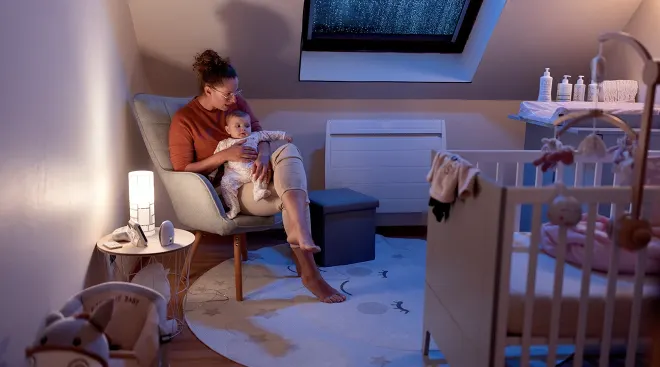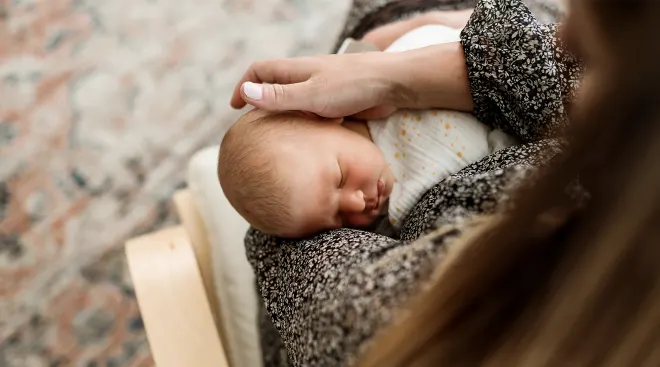When Can Babies Sleep on Their Stomach Safely?
New parents get lots of information thrown at them when it comes to baby sleep, but among the most important pieces of advice is about baby sleep positions. Is putting baby to sleep on their back really best, or can they sleep on their tummy? What happens if, despite your best efforts, you wake up in the middle of the night to find baby sleeping on their stomach? And when can babies sleep on their stomach safely? Here’s what you need to know so you and baby can rest peacefully.
The short answer is no. If baby’s sleeping on their stomach, it means they’re breathing in less air, which can increase their chance of Sudden Infant Death Syndrome (SIDS). According to the CDC, in 2020—the most recent year statistics were available—approximately 1,389 babies died of SIDS.
One of the most concerning aspects of baby sleeping on their stomach is rebreathing. This happens when exhaled air—which can get trapped around baby’s face—is inhaled again. “This air is lower in oxygen and higher in carbon dioxide, which can cause the oxygen levels in the blood to drop,” says Denise Scott, MD, an Oklahoma-based pediatrician and expert with JustAnswer. “Rebreathing is primarily thought to occur when an infant is face-down on a mattress or other surface, or when something covers baby’s face, such as a blanket, pillow, toy, another person or an animal.” The AAP also says soft, adjustable mattresses, including those made of memory foam, can also increase baby’s chances of rebreathing.
The best and only position for baby to sleep is on their back—which the American Academy of Pediatrics recommends through baby’s first year. (Baby shouldn’t sleep on their side either, as they can easily roll onto their stomach.) The National Institutes of Health launched the “Back to Sleep” campaign (now known as “Safe to Sleep”) in 1994 to educate parents and caregivers about why infants should be put to sleep on their backs. Following the campaign, the number of SIDS-related deaths dropped within six years by 50 percent, to current levels.
While some parents are concerned that sleeping on the back might increase risk of choking, it actually does the opposite and improves airflow, says Deborah Campbell, MD, chief of neonatology at the Children’s Hospital at Montefiore in the Bronx, New York. “Baby’s airway anatomy and gag reflex will keep /[choking] from happening,” she says. Even babies with gastroesophageal reflux (GERD) should sleep on their backs. This goes for naps and bedtime, and it’s important to be consistent.
Another common concern parents have with baby sleeping on their back is that they may develop plagiocephaly, also known as flat head syndrome. But according to the Safe to Sleep campaign, it’s not something parents should worry about. Flat spots can occur on baby’s head if they’re laying down in the same position for too long, but these aren’t dangerous and typically resolve on their own as baby starts to practice more tummy time and sit up. Scott also recommends limiting baby’s time in car seats, swings and bouncy chairs during the day to help prevent plagiocephaly. If you notice baby’s head always turning towards one side or if they tilt it towards one shoulder, have your pediatrician rule out torticollis, Scott says. “This is shortening of the muscles on one side of the neck and can also contribute to flattening of the skull.”
So when can baby sleep on their stomach safely? Once they roll themselves, it’s fine. However, pediatricians recommend continuing to put babies down to sleep on their backs until their first birthdays. Typically at this stage, newly minted toddlers are able to sit without support and can roll from back to front. “This requires good head and trunk control,” says Campbell, and it suggests that your little one is strong enough to roll back to safety if they need to.
You’ve done your part and put baby to sleep on their back. But as every new parent knows—no matter how exhausted you are—you can’t help but wake up in the middle of the night to make adjustments should you find baby sleeping on their stomach. The good news is, depending on baby’s age, you might not need to do that. If your child is around 6 months old and has good head and trunk control (which they probably do, if they roll over a lot), then “it’s not necessary to turn baby over onto their back,” Campbell says. (Of course, if you happen to be up, sure, go ahead and adjust them.)
But not all babies wait until the six-month mark to roll over; some as young as 3 or 4 months can turn onto their stomachs while they’re sleeping. If this is the case, Campbell advises gently turning baby onto their back. The following tips can also help keep baby safe throughout the night:
- The American Academy of Pediatrics (AAP) emphasizes that you should never sleep with baby in bed with you.
- Keep baby swaddled during sleep to help them stay on their back. Remember, “once a baby attempts to roll or turn over, it’s important to stop swaddling the baby,” Campbell says.
- Keep the crib clear of toys and blankets, and keep the bedding tight. Loose blankets can increase the risks of SIDS.
- Encourage lots of tummy time when they’re awake, so they have plenty of practice moving onto their back by themselves while you’re able to supervise. (This also helps counteract flat head syndrome.)
- Use a firm crib mattress and make sure it meets safety standards.
- Stay away from wedges or pillows, Campbell says.
At the end of the day, following safe sleep practices is the best way to keep your child safe. Plus, it helps build the healthy habit of sleeping on your back, which many experts have touted as the optimal sleep position. However, if you do have any concerns about your little one or questions about when baby can sleep on their stomach, don’t hesitate to check in with your pediatrician.
Please note: The Bump and the materials and information it contains are not intended to, and do not constitute, medical or other health advice or diagnosis and should not be used as such. You should always consult with a qualified physician or health professional about your specific circumstances.
Plus, more from The Bump:
Denise Scott, MD, is a pediatrician with JustAnswer and a pediatric endocrinologist based in Oklahoma with over 20 years of experience. She received her medical degree from the University of Texas Medical Branch and completed her residency at the University of Oklahoma Health Sciences Center, with a fellowship at the National Institutes of Health.
Deborah Campbell, MD, FAAP, is the chief of neonatology at the Children’s Hospital at Montefiore in the Bronx, New York, as well as a professor of pediatrics at Albert Einstein College of Medicine. She earned her degree from State University of New York at Buffalo and completed her residency at Montefiore Medical Center.
Healthy Children (American Academy of Pediatrics), [How to Keep Your Sleeping Baby Safe: AAP Policy Explained] (https://www.healthychildren.org/English/ages-stages/baby/sleep/Pages/a-parents-guide-to-safe-sleep.aspx))
Learn how we ensure the accuracy of our content through our editorial and medical review process.
Navigate forward to interact with the calendar and select a date. Press the question mark key to get the keyboard shortcuts for changing dates.




















































